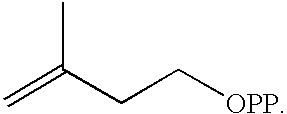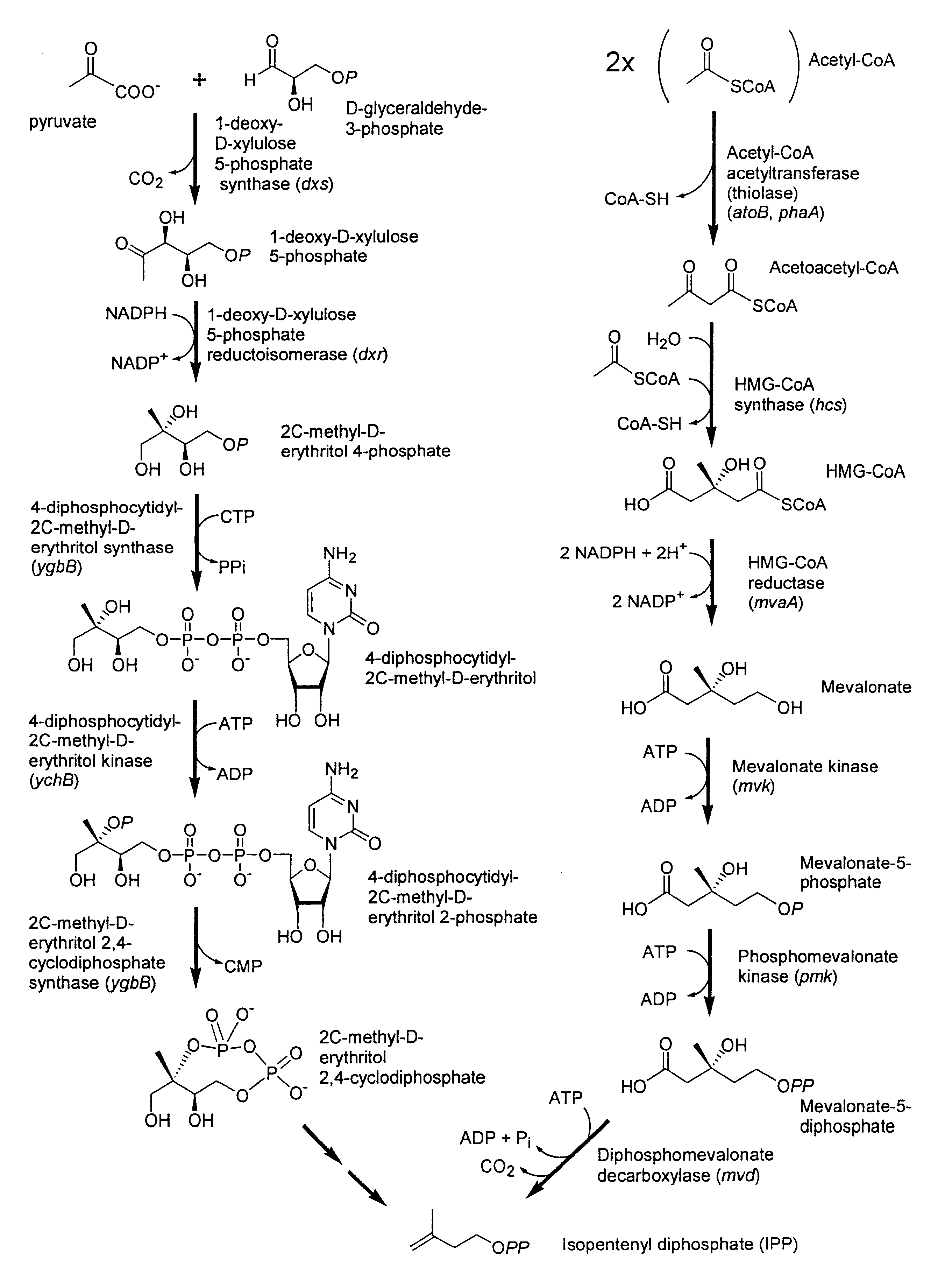Isoprenoid production
a technology of isoprenoid and production process, applied in the field of new products, can solve the problems of insufficient production of carotenoids for economical industrial scale production, unable to produce enough carotenoids for economical production, and early attempts to develop a commercially viable fermentation process for the production of zeaxanthin using classically derived mutants of strain r-1512 were not successful. , to achieve the effect of improving the production of carotenoids
- Summary
- Abstract
- Description
- Claims
- Application Information
AI Technical Summary
Problems solved by technology
Method used
Image
Examples
example 1
Analytical and Biochemical Methods
Analysis of Carotenoids
[0184]Sample preparation. A solvent mixture of 1:1 dimethylsulfoxide (DMSO) and tetrahydrofuran (THF) was first prepared. This solvent mixture was stabilized by the addition of butylated hydroxytoluene (BHT, 0.5 g / l solvent mixture). Four milliliters of the stabilized DMSO / THF mixture was added to 0.4 ml of bacterial culture in a disposable 15-ml polypropylene centrifuge tube (gives a final dilution factor of 1 / 11). The tubes were capped and mixed using a Vortex mixer for 10 seconds each. The samples were then put on a Brinkmann Vibramix shaker for 20 minutes. The tubes were centrifuged at room temperature for 4 minutes at 4000 rpm and aliquots of the clear yellow / orange supernatant were transferred into brown glass vials for analysis by High Performance Liquid Chromatography (HPLC).
[0185]HPLC. A reversed phase HPLC method was developed for the simultaneous determination of astaxanthin, zeaxanthin, canthaxanthin, β-carotene, a...
example 2
Taxonomic Reclassification of Flavobacterium sp. as Paracoccus
[0204]This Example describes the taxonomic re-classification of the zeaxanthin-producing bacterium formerly designated Flavobacterium sp. strain R-1512 (ATCC 21588) as Paracoccus sp. strain R-1512 (ATCC 21588).
[0205]A comprehensive genomic and biochemical / physiological analysis was performed by the Belgian Coordinated Collections of Microorganisms / Laboratorium voor Microbiologie, Universiteit Gent (BCCM™ / LMG), using state-of-the-art methods currently accepted as the scientific standards for bacterial classification. Besides Paracoccus sp. strain R-1512, several other bacteria belonging to the genus Paracoccus were included in the study (summarized in Table 2).
[0206]
TABLE 2Bacteria used in taxonomic study.BacteriumStrain designationSource or referenceParacoccus sp.R-1512 (ATCC 21588)American Type Culture Collection(environmental isolate); Schocher andWiss, U.S. Pat. No. 3,891,504Paracoccus sp.R1534Hohmann et al., U.S. Pat...
example 3
IPP Biosynthesis via the Mevalonate Pathway in the Zeaxanthin-Producing Paracoccus sp. Strain R114.
[0254]In order to determine the biosynthetic origin (i.e., the mevalonate or DXP pathway) of isoprenoid precursors in Paracoccus sp. strain R114, a “retrobiosynthesis” approach (Eisenreich, W. and Bacher, A. In: J. K. Setlow, (ed.) Genetic Engineering, Principles and Methods, Kluwer Academic / Plenum Publishers, New York, Vol. 22, p. 121-153, 2000) was taken. This predictive approach for data analysis permits the unequivocal assessment of glucose catabolism from the analysis of a single down-stream natural product. In the present work, this involved growth of the bacterium in media containing various binary mixtures of unlabeled glucose and specific 13C-labeled glucoses, followed by purification of the zeaxanthin produced and analysis of the labeling patterns by NMR spectroscopy. Details of the methods used and the experimental results are given below.
[0255]Growth of Paracoccus sp. strai...
PUM
| Property | Measurement | Unit |
|---|---|---|
| W/W | aaaaa | aaaaa |
| W/W | aaaaa | aaaaa |
| Tm | aaaaa | aaaaa |
Abstract
Description
Claims
Application Information
 Login to View More
Login to View More - R&D
- Intellectual Property
- Life Sciences
- Materials
- Tech Scout
- Unparalleled Data Quality
- Higher Quality Content
- 60% Fewer Hallucinations
Browse by: Latest US Patents, China's latest patents, Technical Efficacy Thesaurus, Application Domain, Technology Topic, Popular Technical Reports.
© 2025 PatSnap. All rights reserved.Legal|Privacy policy|Modern Slavery Act Transparency Statement|Sitemap|About US| Contact US: help@patsnap.com



